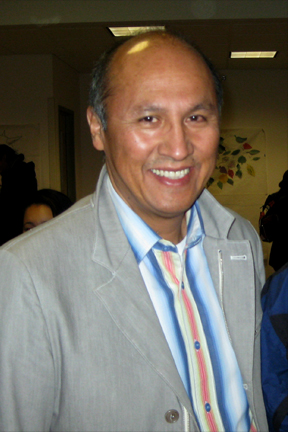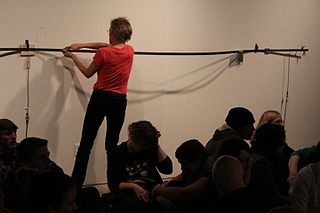Related Research Articles
PAVED Arts is a new media art Artist run centre located in Saskatoon, Saskatchewan, Canada that focuses on what it calls the 'PAVED Arts' arts: photography, audio, video, electronic and digital. PAVED operates an access centre for media production and post-production and an exhibition space for works falling within their mandate.

Gerald Raymond McMaster is a curator, artist, and author and a Plains Cree member of the Siksika Nation. McMaster is a professor at OCAD University and is the adjunct curator at the Remai Modern in Saskatoon, Saskatchewan.

Janet Werner is a Canadian artist based in Montreal. Her work is known for its incisive and playful depictions of female figures, raising questions about the nature of the subject in painting.
Gregory Burke is a New Zealand museum director, writer and curator. In 2013, he was named executive director & CEO of the Mendel Art Gallery, Saskatoon, Canada and the Remai Modern Art Gallery of Saskatchewan.
Lori Blondeau is a Cree/Saulteaux/Métis artist working primarily in performance art, but also in installation and photography. Blondeau is a member of the Gordon First Nation, and is based in Winnipeg, Manitoba.
Edward Poitras is a Métis artist based in Saskatchewan. His work, mixed-media sculptures and installations, explores the themes of history, treaties, colonialism, and life both in urban spaces and nature.

Ellen Moffat is a Canadian media artist who works in sound, image and text in installation and performance. Born in Toronto, Ontario, she now resides in Saskatoon, Saskatchewan.
Martha Cole is a Canadian artist. She is known for her work with textiles, landscape, and artist's books, addressing themes of inter-contentedness, sustainability, and protection of ecological diversity. She currently resides in Disley, Saskatchewan. Cole's high school art teacher, Helmut Becker encouraged her to pursue a career in art. She was an instructor in the Extension Division, Fine Arts and Humanities, University of Regina.
Ruth Cuthand D.F.A. is a Canadian artist of Plains Cree and Scots ancestry. She is considered an influential feminist artist of the Canadian prairies, and is lauded for her interpretation of racism and colonialism. Her work challenges mainstream perspectives on colonialism and the relationships between settlers and Indigenous people in a practice marked by political invective, humour, and a deliberate crudeness of style.

Cheryl L'Hirondelle is a Canadian multidisciplinary media artist, performer, and award-winning musician. She is of Métis/Cree (non-status/treaty), French, German, and Polish descent. Her work is tied to her cultural heritage. She explores a Cree worldview or nêhiyawin through body, mind, emotions, and spirit; examining what it means to live in contemporary space and time.
Honor Elizabeth Kever is a Canadian artist.
Amalie Atkins is a Canadian artist making use of film, fabric-based sculpture and performance. She currently resides in Saskatoon, Saskatchewan.
Erika DeFreitas is a Toronto-based artist who works in textiles, performance and photography.
Tanya Lukin Linklater is an artist-choreographer of Alutiiq descent. Her work consists of performance collaborations, videos, photographs, and installations.
Michelle Jacques is a Canadian curator and educator known for her expertise in combining historical and contemporary art, and for her championship of regional artists. Originally from Ontario, born in Toronto to parents of Caribbean origin, who immigrated to Canada in the 1960s, she is now based in Saskatoon, Saskatchewan.
Zadie Xa is a Korean-Canadian visual artist who combines sculpture, painting, light, sound, and performance to create immersive multi-media experiences. Drawing inspiration from fields such as ecology, science fiction, and ancient religions, her work explores how beings imagine and inhabit their worlds. Her work is centered on otherness and is informed by personal experience within the Korean diaspora, as well as by environmental and cultural contexts of the Pacific Northwest.
Gabrielle L'Hirondelle Hill is a Cree and Métis multimedia artist and writer, living and working in Vancouver, British Columbia, Canada. Through creating sculptures, collage, and installation works with found objects, she explores and questions the capitalistic treatment of land as an economic capital, which leads the land contamination and violence against people living on the land. As a member of BUSH Gallery, Hill is also involved in group art projects, through which artists embody the indigenous way of knowing and art practice, as a means of decentralizing Eurocentric theorization of art. Hill was longlisted for the 2019 Sobey Art Award.
Douglas Bentham has been since the late 1960s, acknowledged as one of Canada's pre-eminent producer of large-scale welded steel sculpture.
Thelma Vivian Pepper was a Canadian artist. She was known for her work as a portrait photographer, which she took up later in life at the age of 60. Her first solo exhibition was in 1986. Themes in her photographs focus on "spirit, community, and little-known stories." Thelma's photographs can be found in archives, galleries and institutions across Saskatchewan.
Clara Hume was a Canadian painter. Her work is largely focused on landscapes and still lifes. Her paintings have been exhibited in Saskatchewan and Manitoba as part of group and solo exhibitions. She was particularly noted for her detailed acrylic paintings of prairie wildflowers and grasses, and prairie landscapes.
References
- ↑ "Linda Duvall". Transart People. Retrieved 2016-03-05.
- ↑ Smith, Steven Ross. "Linda Duvall." Saskatchewan Arts Alliance, 2006. http://www.artsalliance.sk.ca/resources-and-tools/studies-and-facts/2006/910 .
- 1 2 "Linda Duvall". Gallery TPW. Retrieved 2017-03-21.
- 1 2 "PAVED Arts". www.pavedarts.ca. Retrieved 2017-03-20.
- ↑ "CURRENT". Red Head Gallery. Retrieved 2017-03-20.
- ↑ "Home - BlackFlash Magazine". BlackFlash Magazine. Retrieved 2017-03-20.
- ↑ "Linda Duvall". Transart People. Retrieved 2017-03-20.
- 1 2 3 Gale, Peggy (2009). "A long time coming". In Gale, Peggy, Garneau, David, Gaztambide-Fernández, Rubén (ed.). Linda Duvall Where were the Mothers?. Mississauga, Ontario: Art Gallery of Mississauga. pp. 15–23. ISBN 9781895436785.
{{cite book}}: CS1 maint: multiple names: editors list (link) - ↑ Duvall, Linda (2009). "Where were the Mothers?". Dunlop Art Gallery. Retrieved 18 March 2017.
- ↑ "Living in 10 easy lessons".
- 1 2 turions, cheyanne (2012). "Living in 10 Easy Lessons". In Linda Duvall and Peter Kingstone: Living in 10 Easy Lessons. Exhibition brochure, Toronto: G44 Centre for Contemporary Photography. pp. 6-13. Accessed 18 March 2017. https://gallery44.org/exhibitions/living-10-easy-lessons
- ↑ Sandals, Leah (2012). "A look at Living in 10 Easy Lessons by Linda Duvall and Peter Kingstone at Gallery 44 | Toronto Star". thestar.com. Retrieved 2017-03-19.
- ↑ Klassen, Lois. Looking at Word Finding, a Practice-Based Research Project about Participatory and Dialogical Art Processes. [Electronic Resource]. Emily Carr Institute of Art and Design Masters Thesis. [Vancouver] : Emily Carr University, 2011.
- 1 2 Moser, Gabrielle (2012). "Linda Duvall - The Toss." Exhibition Essay. Toronto: Gallery TPW. Retrieved 20 March 2017 http://gallerytpw.ca/exhibitions/lduvall/
- ↑ "Linda Duvall - The Unacknowledged | Remai Modern". Remai Modern. 2016-05-18. Retrieved 2017-03-19.
- ↑ "Sask. art project invites strangers to spend 6 hours in a hole while people watch". CBC News. Retrieved 2017-03-19.